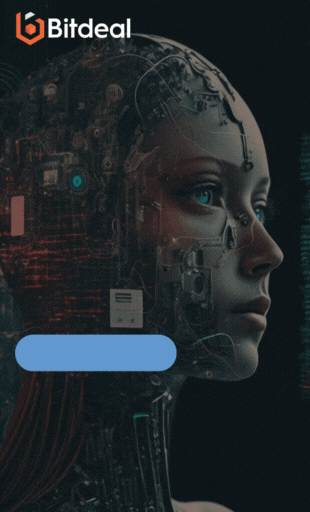Discover the transformative power of Generative AI, in reshaping the Metaverse landscape!
During the pandemic, there was a significant surge of interest in the Metaverse as people sought more meaningful ways to connect with others. However, the initial hype around the Metaverse has subsided since then. Nevertheless, there is a technology that has captured public attention and holds the potential to play a significant role in empowering Metaverse interactions and development: Generative AI. This cutting-edge technology, developed by an AI Development Company, offers creative applications that can address the substantial demands for content creation in virtual worlds with 3D assets.
Prajod Vettiyattil, Principal Architect at Fractal, explains the advantages of using Generative AI in Metaverse development. By utilizing Generative AI, metaverse content can be created from text descriptions, easing the typically labor-intensive process of 3D modeling. Creating a 3D model involves a combination of artistic knowledge about colors, textures, and their combinations. For instance, when designing spaces like banks, schools, or stores, specific color combinations and lighting schemes need to be envisioned and used. Additionally, videos and images must be created and integrated into the 3D model. Generative AI simplifies the creation of virtual spaces, offering customizable options that enhance artistic appeal and expand the range of possibilities. Presently, human designers and developers meticulously curate each space and experience in the metaverse, a process that can take weeks or even months to complete.
Vineet, a Senior Consultant at Fractal, highlights another aspect where Generative AI proves beneficial in the metaverse: ideation. Various Generative AI tools used for 2D visualizations, such as MidJourney and DALL.E 2, can be prompted to emulate the style of any chosen artist, like Van Gogh. This capability opens up avenues for creating unique and personalized metaverse experiences.
One of the most interesting and complex aspects of the metaverse is the creation of avatars. Avatars are virtual beings that can move, talk, and interact like humans. They can represent either real-world individuals or purely virtual entities. Generative AI enables the simulation of realistic thoughts, physical appearances, voices, and movements in the metaverse. By leveraging Generative AI, developers can build AI bots with emotional and conversational characteristics tailored to individual preferences, resembling the AI Virtual Assistant portrayed in the movie "Her," as explained by Prajod.
The simplicity with which generative AI operates is a game-changer. Prajod highlights the value of automating the creation of interactive content and experiences, which traditionally takes years of painstaking animation work and numerous iterations. However, with the aid of generative AI, these tasks can be accomplished within months.
Vineet believes that the applications of generative AI can significantly enhance the overall quality of social interaction by introducing different modalities. Just as voice communication revolutionized interactions after letters and telegrams, generative AI can be used to analyze machine learning algorithms or create music that emulates the style of renowned composers like Mozart. This logic extends to other modes of interaction, such as audio, which can benefit from the future integration of generative AI, much like ChatGPT is utilized to build narratives.
These advancements in generative AI contribute to the fulfillment of the Metaverse's promise of a fully immersive experience. Unlike the text-based interfaces of chat apps or the two-dimensional interfaces of video conference apps, the metaverse allows for kinesthetic interactions, enabling users to turn their heads and move their hands. This level of immersion surpasses the experiences offered by text or video alone.
Generative AI offers value beyond entertainment, extending its benefits to business and education in the Metaverse. Prajod emphasizes that this technology creates new opportunities not only for human interaction and entertainment but also for education. With the Metaverse and Generative AI, there is no need to invest in physically building classrooms and facilities, enabling easier scalability in these sectors.
In the banking sector, which is already leveraging the Metaverse, generative AI opens up possibilities for more advanced virtual interactions beyond automated chat systems. Virtual banks eliminate the need for physical visits or contacting call centers, offering customers a more streamlined and immersive experience. Each virtual customer can have their own personalized customer service representative in the form of avatars, providing visual aspects that allow for facial expressions during conversations. AI bots can access internal data, respond to customer queries, and learn from customer interactions, improving their ability to explain and converse based on each customer's history. The context of conversations can be retained in the metaverse, eliminating the issue of losing context when contacting customer representatives repeatedly.
Furthermore, generative AI has promising applications for visually impaired users by enabling auto-translation and creating content specifically designed for their needs. Real-time communication with people from different parts of the world can also be facilitated through auto-translate speech features.
Generative AI can also address challenges faced in other areas related to the metaverse, such as digital twin technology. Digital twin technology creates replicas of processes or structures connected to the Internet of Things (IoT) endpoints. Generative AI can assist in high-resolution rendering and real-time data transfer, enabling the creation of virtual spaces that simulate real-world scenarios. For instance, a digital twin of a city like New York or Mumbai can showcase virtual representations of roads, signals, and traffic flow, providing solutions to real-world problems like optimizing traffic and suggesting alternative routes.
Generative AI can help overcome limitations related to bandwidth, power, and computing resources in the metaverse. Currently, the high bandwidth requirements of the metaverse pose challenges to delivering a seamless experience. However, generative AI can be utilized to regenerate content on customers' edge devices, making it possible to showcase high-resolution content and improve visual fidelity. This is particularly relevant as many metaverses currently have a cartoonish appearance and low resolution, which generative AI can help address.
The integration of generative AI in the Metaverse unlocks a wide range of possibilities, transforming it into a fully immersive and transformative experience. From empowering content creation to enhancing social interactions, generative AI has the potential to revolutionize various sectors, including finance and education, and overcome existing challenges in the metaverse.
Source: Analyticsindiamag
Trending News

Get notified about interesting updates, blogs, press releases, and news in your inbox.


Financial Year-End
OFFER
